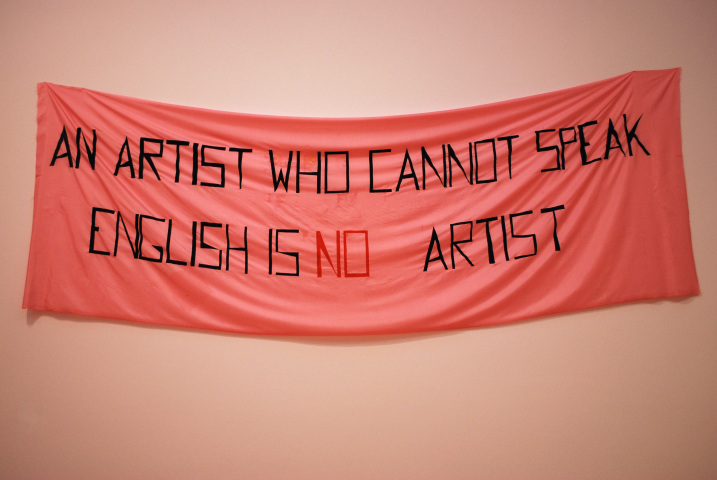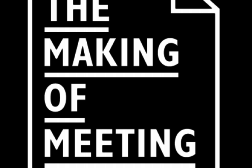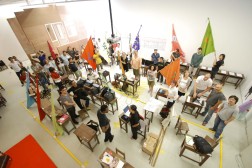
We Are Not Professionals by Hakan Topal
This essay was written as a reflection of the writer’s participation in the Making of the New Silk Roads summit hosted by Arthub in Bangkok.
“We are not professionals” but this does not mean that we are incompetent, unskillful or clumsy. It does not mean that we are hobbyists or ‘Sunday painters’. We are not professionals, because we are not in the business of packaging, distributing, selling, and buying. If being a pro is about making money in exchange for a product or a service, being an amateur is about passion in pursuit of pleasure.
Many artists [1] have suggested that professionalized sex is comparable to professionalized art. The intersecting domains of a restricted economy [the economy of buying and selling] and a general economy [the economy of desire] outline an unworkable unity as an impossible marriage [2]. It is an impossibility because, first, business wants to control and restrict any flows by subsuming it under market rules, while desire can only exist uninterrupted, freely flowing and undisciplined. Second, as opposed to a restricted economic order, in a general economy the more you spend the richer you get, the more you invest the less debt you own.
For example, a sex worker makes love in exchange for money but s/he does not love for money. A lover is, on the contrary, a total amateur; capital does not signify anything as being in love is about sexual attraction, sensuality, and the sensibility of the other. One has to simply love in order to have love and no other condition is necessary to fulfill its requirements as there is no accumulation of love, it happens when it is spent. In this regard, when a sex worker loves, s/he has to give up earning money through the act of sex and become an amateur by rejecting his/her professionalism for a time.
A lover can be silly, outraged, confused, paralyzed, and obsessed. Conversely, a professional, an ideal type [3], has to conduct their work by specific rules of conduct, which are established according to the notion of a restricted economy defined externally by institutionalized frameworks. Professionalization requires specific subjectivation processes to accomplish the job’s requirements beyond just learning the secrets of the trade. This specific disciplining of the body functions as a performative re-positioning according to institutional structures. Repetitive training aims to transform the whole body. Once the body learns how to function, everything is exercised automatically. Professionalization is a total pursuit including how the words are uttered, discourses are developed and behavioral patterns are shaped. In short, a profession is an institutionalized practice, which produces forms, structures and therefore value.
Here I need to make a clear distinction: we should not confuse performativity with theatrical performance. Theatricality implies that there is a stage, back stage, an audience, an outside, a real life beyond the visible. Stage analogy is based on the concept of a social sphere composed of visible/invisible and real/unreal. Contrary to these binary oppositions, professionalization aims for a complete overhauling of life, no hidden domain exists beyond the visible and the performative presence is reality. Becoming a pro is the process of constantly reformatting, reconditioning, and reshaping the body. A professional, such as a lawyer, doctor, firefighter or architect is defined according to its rules of conduct in addition to social cultural dispositions associated to the job. The exceptions to jobs overall requirements can only exist as variations tolerated by the practice itself [4].
My aim here is not to discredit professionalism; there is nothing wrong with selling services. In one way or another we all have to work and are subjected to external power dynamics exercised directly on our bodies. Our question needs to be specifically reformulated in regard to the constitutive potentials of the artistic field. The question is the most general one; is it still possible to seek a “line of escape”? From elementary school to university, from hospital to courthouse, from factory to prison, our bodies are disciplined by series of discursive configurations [5]. If the total subsumption of life under a capitalist order is indicative of recent restructuring of societies, how can an alternative model work without being destined to failure? One can only hope that art has the potential to cut through pre-defined class dispositions and to raise diverse questions.
However, let’s start once again, “we are not professionals”; this does not mean that we are naive. It is apparent that art plays a major role in the justification of the re-feudalization of society. Artists, curators and dealers position themselves so that they can engage with the wealthy and powerful few situated at the top of the food chain. Artists make appearances at art fairs and engage with their collectors. These events are staged by and for those who can collect, store, and benefit from this closed circuit. When collectors become part of the intellectual dialogue, the nature of the production is subsumed under a capitalist re-valuation process. But our difficulty is not the artists who are selling out to this “system”. We have to understand that any attack on “selling artists” are made on relatively moral grounds, similar to society’s disapproval of sex workers. This kind of attack is weak and dilutes the real structural inequalities in societies. Limiting our argument only to the supply-side, hides the real mechanisms of the whole construction of demand and supply as a system.
“We are not professionals” is a rejection of the models that are presented by the neo-liberal institutional system, in which education plays a big part in producing required mobile exploitable subjectivities. Many art programs produce artist/curator types who are mute, reserved and presentable radicals. Since these programs are considered and function more like launching pads for commercial enterprises, artists are becoming extremely cautious, politically correct and relatively well behaved.
In addition to the rejection of capitalist circulation and the re-evaluation process, we need to be aware of the fact that culture is increasingly dominated mostly by the Anglo-Saxon model of cultural institutions. In this regard, “An Artist Who Cannot Speak English Is No Artist”, a conceptual piece by Mladen Stilinović, highlights the art world’s inability to cope with a truly multi-cultural world. Stilinović asserts that in order to function in the contemporary art scene an artist must circulate within an international arena by utilizing commonly excepted norms and when s/he fails to do so they are ignored. Stilinović’s critique is particularly poignant, as it also highlights the art world’s inability to see beyond a discursive articulation of art. If an artist cannot speak English, they cannot apply to exhibitions, funding and correspond with curators and so on. Obviously artistic expression is not bound by the use of language but it is clear that the ability to function within institutional circles depends on this specific professional articulation. If an artist does not fit to “western standards”, s/he will not be recognized as an artist and this is why most non-western artists who work on an international level are actually educated within western educational systems.
Obviously there are many alternatives to conventional market-driven art fairs and establishments. Conferences, symposia and meetings are important parts of artistic intellectual exchange as they serve a vital role in establishing new connections, forming collaborations and developing new ideas. But when these meetings become another venue for self-promotion, the space for salient engagement is usually hijacked by descriptive Power Point presentations composed of endless installation shots. Alongside this, we usually listen to an artist speaking in English and justifying their work through various typical statements, mostly focusing on particularly personal experiences, etc. This attitude is the exact opposite of artistic practice because art requires giving up clichés, developing new approaches, and being experimental.
Generally speaking, art dwells on impossibilities and is an infinite oscillation between knowing, not knowing, understanding, not understanding, meaning and non-meaning. Its constitutive powers come from the playful and unpredictable character of this ambiguity. When Arthub Asia curators Defne Ayas and Davide Quadrio proposed a performative symposium, it was a call to rethink the possibility of creating a new form of engagement between different subjectivities situated all over the world. The outcome was for the most part refreshing and it was an active reevaluation of current conditions in the Asian continent. Giving up dominant models of presentations, and rethinking the performative aspects of artistic engagement was aligned with the experimental nature of our practice.
The “performative symposium” provided a unique opportunity to develop distinctive forms of engagement with each other’s work, something that we are missing in conventional cultural institutions, art fairs and so on. Rethinking the exhibition space as an elementary school classroom asserted that we better have a stimulating connection with the world as students. A classroom setting implies a direct power relationship between the school (institution) and the learning subjects and it has its problems as a model for alternative engagement. However, in order to develop a democratic encounter with one another, it constituted an alternative public space, where the public could join and discuss the issues at hand.
The main issue addressed in the symposium was the possibility of “the making of the new silk roads”. Curators put this forward as a territorial statement by posing a series of questions prior to the conference, which suggested that we imagine a terrain characterized by the condition for new possibilities. In fact, on the one hand the lack of commercial support provides an opportunity as our expression is not regulated by capitalist circulation and professionalized articulations, and as artists this forces us to operate solely as public intellectuals. On the other hand, we are all aware of the fact that Asia is full of semi-democratic or dictatorial governments defined by strict national borders, in direct opposition to the semi-fluidity of the original silk roads, and we are living in conditions where, for the most part, expression is mediated and extreme power is exercised on citizens of the continent. In that respect “we are not professionals” is a declaration that we will proceed with our amateur desires and pursue our alternative interests. Instead of crying for commercial infrastructure and support, we need to activate alternative networks by utilizing given conditions strategically and efficiently.
1. We can revisit two similarly conceived performance works; Marina Abramovic’s performance “Role Exchange” (1975), where she exchanged professional roles with an Amsterdam prostitute, working as a prostitute for four hours while the prostitute worked as an artist. In Andrea Fraser’s “Untitled” (2003) an American collector paid approximately $20,000 dollars to have sex with Fraser in a hotel room, while it was recorded on video.
2. Derrida, Jacques. Writing and Difference. Chicago: University of Chicago Press, 1978: 317
3. Ideal type is a term used By Max Weber as a conceptual tool to comparatively measure the general principals of social phenomenal and it is completely fictional in nature. Ideal types are not to be found in reality as such. Here my aim is to use to show that the disciplines are generating the ideal types is order to sustain a common ethical denominator.
4. A doctor, a lawyer can step outside of the normative frameworks that are presented by the profession, yet they have to be extremely careful how they conduct this transgression. For instance a curator can not be a dealer at the same time.
5. Foucault, Michel. Discipline and Punish : The Birth of the Prison. 2nd Vintage ed. New York: Vintage Books, 1995.



